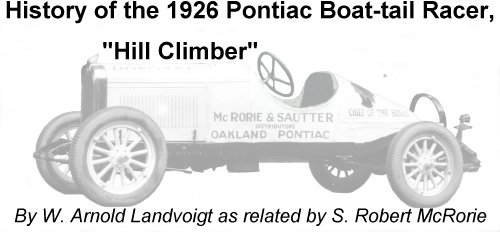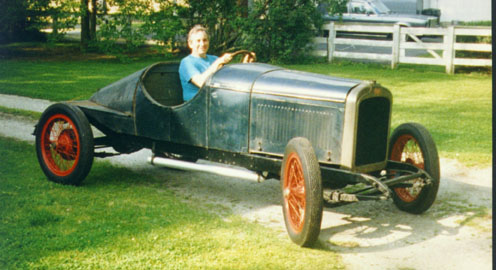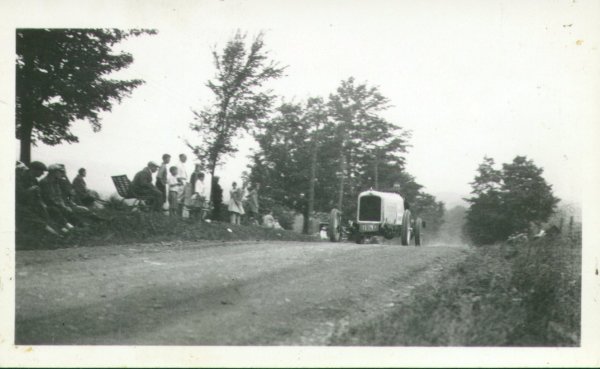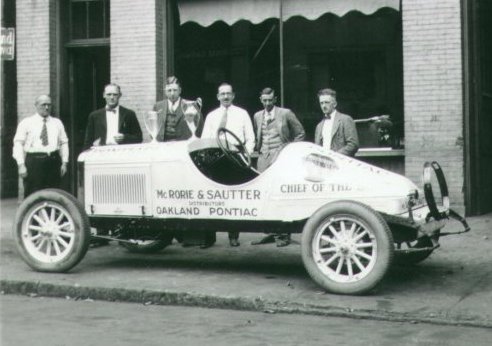

SUMMARY
Hill Climber, the earliest known Pontiac race car, was produced
very early in 1926, Pontiac's initial production year. A two door sedan,
it was sold in Utica, New York, where it was destroyed in a fire. The chassis
was rebuilt into an open, boat tailed racer to compete in local hill climbs.
On Saturday, 14 August, 1926, it competed for the first time at an event
at Sherrill, New York. It won first in its class, taking two trophies
and a $20 cash prize. Hill Climber continued to be raced in the Utica area
into the early 1930s.
A DISCOVERY
On May 23, 1997, I found the following ad on a computer bulletin board at my work:

Figure 1 - The author shortly after acquiring Hill Climber
Based upon a name and town given me by the seller I was able to locate
and meet
S. Robert (Bob) McRorie, son of the man who converted the Pontiac into
a race car in the 20's. Through him I have been able to construct the following
history of the car they called "Hill Climber" as it was touched by three
generations of the McRorie family in Utica, New York.
PONTIAC - THE WINNER FROM THE START
In 1926 McRorie - Sautter was an Oakland automobile dealership and distributor in Utica when General Motors introduced the Pontiac automobile through their Oakland outlets. The car, a two door sedan, serial number 3974, was produced and sold in the first months of that year. McRorie - Sautter Motor Company, then at 122 Seneca Street in Utica, had been an automobile dealer since 1920 initially selling Holmes and then Chandlers in 1923, prior to switching to Oakland in 1924. At an undetermined point after the car's sale, the owner suffered a fire, which destroyed the passenger compartment. The damaged car came back to the dealership. Fred McRorie, Bob’ s father, had the chassis taken across town to the Willoughby Company, a local coach builder of national renown for their custom bodies on high-end automobile chassis. The Willoughby plant was located in East Utica near the Savage Arms Company. There the burned body was cut off at the forward edge of the doors and a boat-tail style, open body was fashioned of steel over wood framing. The very basic level of the finish work and lack of a Willoughby number plate would seem to indicate that the conversion was done as something of a "quick and dirty" job. It was certainly not in keeping with the fit and finish of the "high-end" conversions for which the Willoughby Company was known. This work was done by late summer of 1926 when local newspaper articles describe the car successfully competing in the Sherrill hill climb on August 14, 1926, the first known race for Hill Climber or any other Pontiac for that matter. Hill Climber competed in other races that year and repeated it's first success a year later at the Sherrill hill climb on July 30, 1927.
Hill Climber, as the family called the car, was painted white with advertising on the sides and back; the dealership's name on the sides and the Pontiac Chief head profile with the slogan, "Pontiac, Chief of the Sixes" on the sides of the rear deck. It was driven by Warren "Mandy" Mandeville, an employee of the dealership. Gabriel snubbers, a precursor to modern shock absorbers, are visible in the early photos and the straight through exhaust was likely added in the initial conversion. As the car was raced in the last half of the decade other modifications were made. A larger diameter 1928 manifold was fitted with a Stromberg OA-1 carburetor and larger 1 1/2 inch valves were installed. The original 20 inch wooden spoked wheels were replaced with 21 inch Buffalo wire wheels and hubs. This provided a larger, stiffer, taller wheel. The 4.18:1 Pontiac ring and pinion were also replaced with what appears to be a 3.818:1 Chevrolet unit. These last changes combined to give the car a higher final drive ratio and thus a higher top speed.

Figure 2 - " 'Hill Climber" over the top at Vickerman Hill a real winner! A Pontiac chassis and a Willoughby body!" - Photo 1926, text from a 1972 McRorie-Sautter ad.
Throughout the last half of the decade and into the early 1930s the
car was raced in local hill climb events. In addition to the Sherrill events
these are believed to include events at Red Hill in the community of Washington
Mills outside of Utica, Sauquoit, Kirkland Hill west of Kirkland on route
5, Deerfield Hill out of Mowhawk Valley, and Vickerman Hill near Herkimer.
Hill climbs were important publicity opportunities for the dealerships
of that period as they demonstrated an auto's ability to negotiate the
long, steep, curvy hills in the area, sometimes problematic in cars of
the day. In fact, Bob McRorie recalled his father taking he and his mother
to Red Hill on Sunday afternoons to practice climbing the hill in top gear.
This was in anticipation of taking potential customers on demonstration
rides. The organized hillclimbs were quite popular with the public. Coverage
of an earlier event, the 1921 Vickerman
Hill Climb, by the Utica Times-Dispatch reported a crowd of near 20,000.
HARD TIMES
Hill Climber was retired from racing by 1932 when McRorie-Sautter switched brands from Oakland-Pontiac to Buick. To cover the Pontiac lettering and Indian head logos, the car was repainted a dark blue-green. For a time it is believed to have been used as a run about by employees and later spent some years sitting in the corner of the showroom. Eventually it was moved to the third floor body shop area of the dealership's later location on the corner of Columbia and State Streets.

Figure 3 - In front of the Seneca Street dealership in 1926.
Fred McRorie 3rd from right, Warren "Mandy" Mandeville
far right.
In the late 30’s Bob McRorie took over management of the dealership from his father. While automobiles were Bob's business for four decades, they were not his hobby. Although he had little personal interest in racing or driving the old race car, he did take care of it, having his mechanics annually grease it and change the oil.
Bob's son, Fred, on the other hand, took an early interest in cars and in his teen years spent much time in the dealership's body shop becoming quite skilled. In the spring of 1962 Fred took an interest in the old race car stored there and, with the help of a shop mechanic, Harry Lohman, got it started. Tragically, on the Saturday before Easter, April 21, 1962, young Fred was killed in an unrelated road accident at Ilion Gorge.
Hill Climber fell into disrepair and eventually was moved out of Utica to a camp near the town of Gray, flat towed on the bare rims. It was stored there for some years in a barn, eventually returning to Utica when the camp was sold.
Bob McRorie continued in the Buick business until 1978. In 1983 he retired to southern Virginia where he lived with his wife Mary until his death in November, 1998.
At some point, probably around 1978 with the closing of the McRorie
Sautter Buick dealership, the car came into the possession of Jerry Cooper,
a childhood friend of Bob's son, Fred. Jerry and Fred had shared a common
interest in tinkering with cars throughout high school.
FOUND
By 1991 Mr. Cooper was living in Maryland between Baltimore and Washington when the car again changed hands to Bob Davison of Ellicott City, Maryland. Mr. Davison, a friend of the Coopers, began restoration. He rebuilt the wire wheels and had new tires mounted. The body was taken off the frame and the frame and running gear repainted in black. The body paint received some level of cleaning and he began cleanup of the engine and drive train..
Since receiving the car, I have worked to both build the history of this vehicle and continue the restoration. In 1998 a rudimentary valve job was performed, the gas tank sealed and a new radiator core installed. That summer the engine ran again for only the second time in over 60 years. As received the odometer indicated 22, 450 miles, which Mr. McRorie stated is the correct original mileage. In the fall of 1999 the car completed 5 laps of the Summit Point Raceway in West Virginia at speed. That winter the body sheet metal was removed to refurbish the underlying wood which was in bad shape. This work was completed in Spring, 2001. That summer the car was repainted to the original white paint scheme with lettering as in the 1926 photos. Simple, leather covered seat cushions and reinstallation of wooden artillery wheels brought the car back to its original race configuration. The car is now being shown at both local and national events.
This car is significant as it is the earliest known Pontiac race car, and one of only a limited number of Pontiacs of any sort surviving from the initial production year. Documentation of this history was submitted to the Antique Automobile Club Of America in 1999. That year the history of Hill Climber was certified by AACA in Class 24 B, Competition - road course or hill climb.
I continue to attempt to rebuild the history of hill climb racing in upstate New York in the 1920's and welcome any contributions of information or ephemera. I will share this history with any interested historical societies. Copies of all information has been provided and are available in the Collier Research Room at The International Motor Racing Research Center at Watkins Glen, Watkins Glen, New York.
Arnold Landvoigt, March, 2001
Box 826
Savage, Maryland 20763
or by e-mail at: